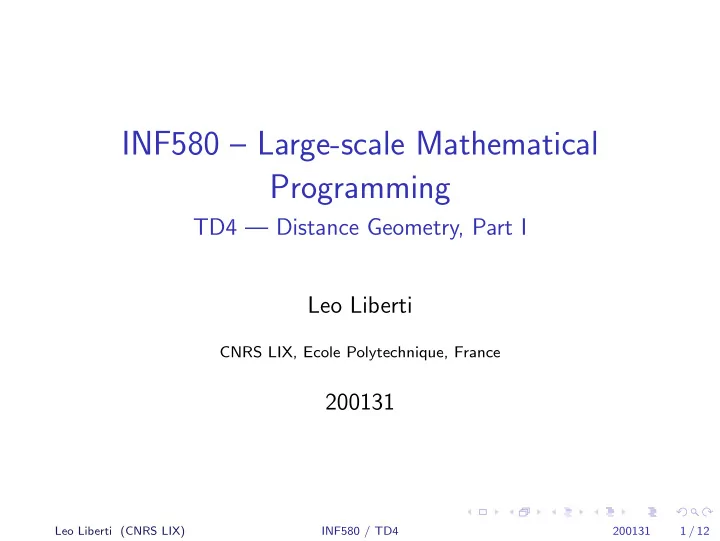

INF580 – Large-scale Mathematical Programming TD4 — Distance Geometry, Part I Leo Liberti CNRS LIX, Ecole Polytechnique, France 200131 Leo Liberti (CNRS LIX) INF580 / TD4 200131 1 / 12
Universal Isometric Embedding ◮ Given metric space X with | X | = n and distance matrix (DM) D ◮ UIE: finds embedding in ℓ n ∞ ◮ Define x ik = D ik for all i , k ≤ n ◮ Thm. : the DM of x is D proof seen in lecture ◮ Every graph G = ( V , E ) gives rise to a metric space take X = V and d ( u , v ) = length of shortest path u → v Leo Liberti (CNRS LIX) INF580 / TD4 200131 2 / 12
Universal Isometric Embedding Exercises (use AMPL): 1. Generate random weighted biconnected graph G with | V | = 50 output to AMPL .dat 2. Verify its connectedness using Floyd-Warshall’s all-shortest-paths algorithm 3. Construct the DM ¯ G of the metric space induced by G 4. Find the UIE x of ¯ G in ℓ ∞ 5. Verify the DM of x in ℓ ∞ is ¯ G 6. Reduce the dimensionality of x to K ∈ { 2 , 3 } and draw the realization see below for PCA details Leo Liberti (CNRS LIX) INF580 / TD4 200131 3 / 12
Principal Component Analysis ◮ PCA involves finding eigenvalues and eigenvectors ◮ AMPL can do it, but it’s painful and inefficient ◮ Let’s use Python instead Leo Liberti (CNRS LIX) INF580 / TD4 200131 4 / 12
PCA: dist2Gram ## convert a distance matrix to a Gram matrix def dist2Gram(D): n = D.shape[0] J = np.identity(n) - (1.0/n)*np.ones((n,n)) G = -0.5 * np.dot(J,np.dot(np.square(D), J)) return G Leo Liberti (CNRS LIX) INF580 / TD4 200131 5 / 12
PCA: factor ## factor a square matrix def factor(A): n = A.shape[0] (evals,evecs) = np.linalg.eigh(A) evals[evals < 0] = 0 # closest SDP matrix X = evecs sqrootdiag = np.eye(n) for i in range(n): sqrootdiag[i,i] = math.sqrt(evals[i]) X = X.dot(sqrootdiag) # because default eig order is small->large return np.fliplr(X) Leo Liberti (CNRS LIX) INF580 / TD4 200131 6 / 12
PCA: pca ## principal component analysis def PCA(B,K): x = factor(B) # only first K columns x = x[:,0:K] return x Leo Liberti (CNRS LIX) INF580 / TD4 200131 7 / 12
PCA: main import sys import numpy as np import math import types from matplotlib import pyplot as plt from mpl_toolkits.mplot3d import Axes3D myZero = 1e-9 K = 3 # can be 2 or 3 f = sys.argv[1] # read input filename from command line lines = [line.rstrip(’\n’).split()[2:] for line in open(f) if line[0] == ’x’] n = len(lines) # turn into float array X = np.array([[float(lines[i][j]) for j in range(n)] for i in range(n)]) G = dist2Gram(X) # if X produced by UIE, X = its own dist matrix x = PCA(G,K) if K == 2: plt.scatter(x[:,0], x[:,1]) elif K == 3: fig = plt.figure() ax = Axes3D(fig) ax.scatter(x[:,0], x[:,1], x[:,2]) plt.show() Leo Liberti (CNRS LIX) INF580 / TD4 200131 8 / 12
PCA: exercise Use Python code to display UIE of 50-vtx rnd graph in 3D Leo Liberti (CNRS LIX) INF580 / TD4 200131 9 / 12
Distance Geometry Problem Use AMPL to implement 4 DGP MP formulations 1. System of quadratic equations (sqp)): � x u − x v � 2 2 = d 2 ∀{ u , v } ∈ E uv 2. Slack/surplus variables (ssv): � s 2 uv | ∀{ u , v } ∈ E � x u − x v � 2 2 = d 2 � � min uv + s uv { u , v }∈ E 3. Unconstrained quartic polynomial (uqp): ( � x u − x v � 2 2 − d 2 uv ) 2 min � { u , v }∈ E 4. Pull-and-push (p&p): � x u − x v � 2 2 | ∀{ u , v } ∈ E � x u − x v � 2 2 ≤ d 2 � � � max uv { u , v }∈ E and test them with the protein graph tiny gph.dat Leo Liberti (CNRS LIX) INF580 / TD4 200131 10 / 12
DGP: the tiny gph instance Leo Liberti (CNRS LIX) INF580 / TD4 200131 11 / 12
Distance Geometry Problem ◮ Use Python to draw the 4 realizations in 3D sqp ssv uqp p&p none found are they similar? ◮ Compute the UIE of tiny gph.dat are there high values in UIE? Why? ◮ Use PCA to display it in 3D with high values (left) / replace high values by -1.00 (right) Leo Liberti (CNRS LIX) INF580 / TD4 200131 12 / 12
Recommend
More recommend